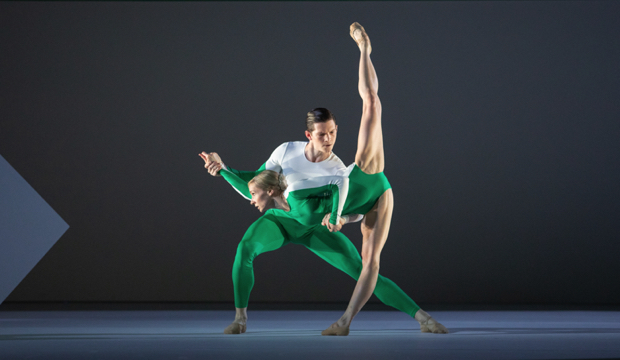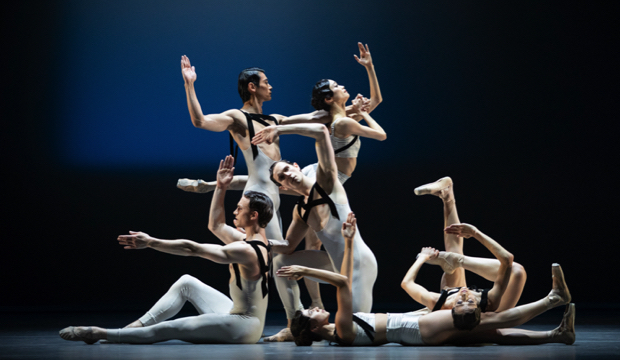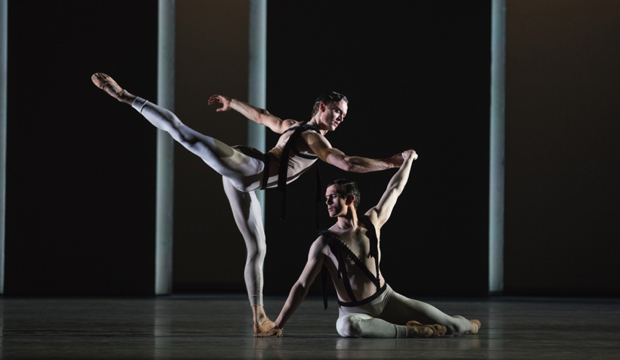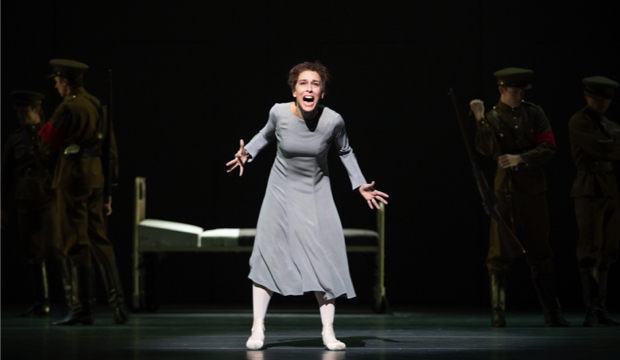Review: The Royal Ballet, McGregor/Wheeldon/ MacMillan ★★★★★
The Royal Ballet’s last programme of the season features works by Wayne McGregor, Christopher Wheeldon and Kenneth MacMillan in a triple bill of contrasting aesthetics and emotions
Artists of The Royal Ballet in Untitled 2023. The Royal Ballet © 2023 Photo: Alice Pennefather
Pure abstraction; witty neo-classicism; expressionism are the headline tags of the works in the Royal Ballet’s final triple bill of the season at Covent Garden.
It opens with company resident choreographer Wayne McGregor’s latest work, Untitled 2023. Narrative holds no great attraction for McGregor, who much prefers to concentrate on movement for its own sake. Unsurprisingly, then, for this latest piece he sought inspiration in the works of the uncompromising Cuban-American abstract minimalist artist Carmen Herrera (1915–2022).
Herrera’s asymmetric gash of green cuts across the backcloth, behind a white geometric solid. The dancers’ minimalist green and white unitards, created by Burberry, reflect Herrera’s aesthetic in individual designs; Lucy Carter's lighting follows Icelandic composer Ana Thorvaldsdottir’s eerie, distant-sounding score in enhancing or subduing the visual element.
McGregor’s choreography for his 19-strong cast divides into duets, solos and ensemble pieces, somewhat incongruously incorporating pure balletic steps – fouettés, split jetés, beaten brisé-volés – into his own trademark contractions, jerky arm movements and hyper-extensions.

Melissa Hamilton and Harris Bell in Untitled 2023, The Royal Ballet ©2023. Photo: Alice Pennefather
The dancers respond well to the demands of McGregor’s style, with Joseph Sissens particularly strong in his vigorous opening duet with Leo Dixon, reprised later in the piece.
The cold, abstract surface of McGregor’s Untitled 2023 contrasts vividly with Christopher Wheeldon’s warm, witty, totally involving Corybantic Games, which follows.
Created in 2018 as part of the commemorations of Leonard Bernstein’s centenary, and set to Bernstein’s Serenade after Plato’s 'Symposium', it goes back to ancient Greece, referencing classical athletes and lovers, the dancers costumed by Erdem.

Artists of The Royal Ballet in Corybantic Games, The Royal Ballet ©2023. Photo: Alice Pennefather
Jean-Marc Pouissant’s immensely intelligent sets carry the mere suggestion of classical colonnades, shifting shape subtly to frame the piece’s five sections under Peter Mumford’s transforming lighting.
Wheeldon blends the classical vocabulary of his training with a very modern sensibility and wit to create his very own dance language. The opening duet between Matthew Ball and William Bracewell is a wonder of fluidity, balance and gentle emotion.

Matthew Ball and William Bracewell in Corybantic Games, The Royal Ballet. © 2018 ROH.. Photo: Andrej Uspenski
Later Fumi Kaneko and Ryoichi Hirano enthral with their wit and preternatural coordination, in a fast, sharp duet; and Mayara Magri owns the stage in the flowing solo that introduces the final section.
The programme ends with another radical mood shift in Kenneth MacMillan’s Anastasia Act III. MacMillan originally created this as a stand-alone piece when he was working in West Berlin and tempted to experiment with German expressionism.
He was intrigued by Anna Anderson, the woman who claimed to be Grand Duchess Anastasia, the sole survivor of the murder of the Russian Imperial Romanov family.
The piece is set in the woman's dark, claustrophobic asylum room, where in her ever more disturbed state she is haunted by memories, or hallucinations of her past life. The sinister monk Rasputin, danced with customary power by Ryochi Hirano, is ever present; her husband, a solid performance from Bennet Gartside, provides an all-too-brief anchor.
But, of course, the ballet is centred on the figure of Anastasia/Anna Anderson, and on opening night Laura Morera offered a harrowing portrayal of her mental torment.

Laura Morera in Anastasia Act III, The Royal Ballet ©2023. Photo: Alice Pennefather
Laura Morera will alternate with Natalia Osipova in the title role, with the performance on Saturday 17 June marking Morera's retirement after a remarkable career with The Royal Ballet.
Read our end-of-career interview with Laura Morera HERE.
Age guidance: 12+
It opens with company resident choreographer Wayne McGregor’s latest work, Untitled 2023. Narrative holds no great attraction for McGregor, who much prefers to concentrate on movement for its own sake. Unsurprisingly, then, for this latest piece he sought inspiration in the works of the uncompromising Cuban-American abstract minimalist artist Carmen Herrera (1915–2022).
Herrera’s asymmetric gash of green cuts across the backcloth, behind a white geometric solid. The dancers’ minimalist green and white unitards, created by Burberry, reflect Herrera’s aesthetic in individual designs; Lucy Carter's lighting follows Icelandic composer Ana Thorvaldsdottir’s eerie, distant-sounding score in enhancing or subduing the visual element.
McGregor’s choreography for his 19-strong cast divides into duets, solos and ensemble pieces, somewhat incongruously incorporating pure balletic steps – fouettés, split jetés, beaten brisé-volés – into his own trademark contractions, jerky arm movements and hyper-extensions.

Melissa Hamilton and Harris Bell in Untitled 2023, The Royal Ballet ©2023. Photo: Alice Pennefather
The dancers respond well to the demands of McGregor’s style, with Joseph Sissens particularly strong in his vigorous opening duet with Leo Dixon, reprised later in the piece.
The cold, abstract surface of McGregor’s Untitled 2023 contrasts vividly with Christopher Wheeldon’s warm, witty, totally involving Corybantic Games, which follows.
Created in 2018 as part of the commemorations of Leonard Bernstein’s centenary, and set to Bernstein’s Serenade after Plato’s 'Symposium', it goes back to ancient Greece, referencing classical athletes and lovers, the dancers costumed by Erdem.

Artists of The Royal Ballet in Corybantic Games, The Royal Ballet ©2023. Photo: Alice Pennefather
Jean-Marc Pouissant’s immensely intelligent sets carry the mere suggestion of classical colonnades, shifting shape subtly to frame the piece’s five sections under Peter Mumford’s transforming lighting.
Wheeldon blends the classical vocabulary of his training with a very modern sensibility and wit to create his very own dance language. The opening duet between Matthew Ball and William Bracewell is a wonder of fluidity, balance and gentle emotion.

Matthew Ball and William Bracewell in Corybantic Games, The Royal Ballet. © 2018 ROH.. Photo: Andrej Uspenski
Later Fumi Kaneko and Ryoichi Hirano enthral with their wit and preternatural coordination, in a fast, sharp duet; and Mayara Magri owns the stage in the flowing solo that introduces the final section.
The programme ends with another radical mood shift in Kenneth MacMillan’s Anastasia Act III. MacMillan originally created this as a stand-alone piece when he was working in West Berlin and tempted to experiment with German expressionism.
He was intrigued by Anna Anderson, the woman who claimed to be Grand Duchess Anastasia, the sole survivor of the murder of the Russian Imperial Romanov family.
The piece is set in the woman's dark, claustrophobic asylum room, where in her ever more disturbed state she is haunted by memories, or hallucinations of her past life. The sinister monk Rasputin, danced with customary power by Ryochi Hirano, is ever present; her husband, a solid performance from Bennet Gartside, provides an all-too-brief anchor.
But, of course, the ballet is centred on the figure of Anastasia/Anna Anderson, and on opening night Laura Morera offered a harrowing portrayal of her mental torment.

Laura Morera in Anastasia Act III, The Royal Ballet ©2023. Photo: Alice Pennefather
Laura Morera will alternate with Natalia Osipova in the title role, with the performance on Saturday 17 June marking Morera's retirement after a remarkable career with The Royal Ballet.
Read our end-of-career interview with Laura Morera HERE.
Age guidance: 12+
TRY CULTURE WHISPER
Receive free tickets & insider tips to unlock the best of London — direct to your inbox
| What | Review: The Royal Ballet, McGregor/Wheeldon/ MacMillan |
| Where | Royal Opera House, Bow Street, Covent Garden, London, WC2E 9DD | MAP |
| Nearest tube | Covent Garden (underground) |
| When |
09 Jun 23 – 17 Jun 23, 19:30 Sat 10 June at 19:00 Dur.: TBC |
| Price | £4-£105 |
| Website | Click here to book |